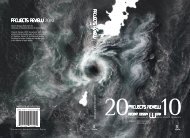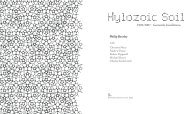The Inner Studio - Riverside Architectural Press
The Inner Studio - Riverside Architectural Press
The Inner Studio - Riverside Architectural Press
Create successful ePaper yourself
Turn your PDF publications into a flip-book with our unique Google optimized e-Paper software.
PART TWO | THE CREATIVE INSTINCT<br />
of myself that I didn’t realize was hungry is fulfilled by this nourishment.<br />
It lets me grow and include aspects of myself that would otherwise be<br />
excluded.<br />
<strong>The</strong> purpose of the following exercises is to become more familiar<br />
with what moves you. You will get to know who you are through what<br />
you like.<br />
1. Make of list of your favorite things. Visualize them or bring some of<br />
them together. Arrange them in some form of composition.<br />
Everything we choose has a meaning. What do these things have in<br />
common? Ask yourself why you like them? What are their design<br />
qualities? What do they have to say to you? Go through each room<br />
in your house and reflect on the space and its artifacts. You can even<br />
look at your city in the same way.<br />
2. Use your imagination to visualize something that would make you<br />
happy. Something that would make your family or community<br />
happy. Something that would make your town or city happy.<br />
3. Think of the place where you spend most of your time. Are you at<br />
home there? If so, why? What makes that place feel “right”? If it<br />
doesn’t, why not?<br />
Starting a project by connecting to your heart’s desire generates<br />
the creative power necessary to survive the resistance, constraints,<br />
and hardship that inevitably accompany the transformation of an<br />
idea into matter. <strong>The</strong> complexity, doubt, and difficulty that naturally<br />
occur in the planning, managing, and construction of<br />
something will overwhelm a project that does not have a heartfelt<br />
essence at its core. Projects that have this heartfelt essence inspire<br />
people. At the same time, with this starting point, the designer<br />
must guard him or herself against the arrogance and sense of<br />
power that can easily seduce us and spoil our creativity.<br />
As a designer recognizes the sensation of being moved, a new<br />
phase of development begins. Anyone can be open and therefore<br />
moved, but for designers this moment has even greater significance<br />
and responsibility; it is the precise moment when the possibility of<br />
transformation comes alive. <strong>The</strong> designer’s new responsibility at this<br />
point is to investigate exactly what has moved him or her and why.<br />
33





